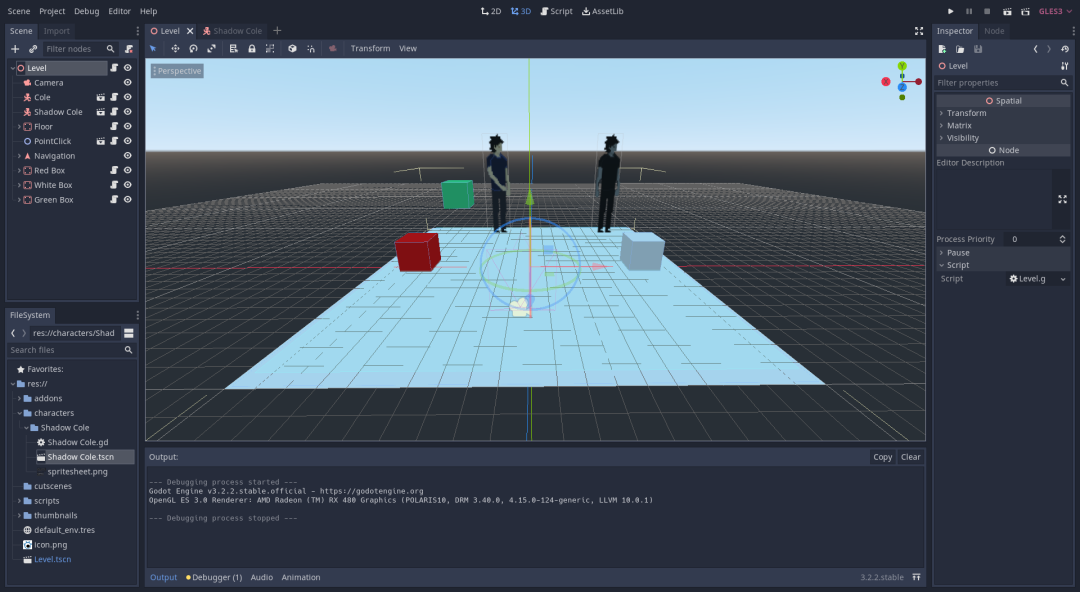QuickStart - Character Interaction
As you saw on previous tutorials, PACgd simplifies creating interactions between Characters and Objects. In this tutorial we will see how to create Interactions between two or more Characters.
Table of contents
Import PACgd Quickstart - Character Interaction
Download the PACgd example projects and extract its content into a folder in your computer. Then, import the project “Character_Interaction” in Godot.
Understanding the Scene
Once the project is imported, Godot will open and you should see a scene with two character (Cole and Shadow Cole) and three boxes: Red Box, Green Box, and White Box.

Before we dig into the scene and its components, play the game! Press F5 or the play button on the top-right corner.
The Objects
The objects in this scene are the same as in our Cutscene tutorial, with the addition of Shadow cole
The Code - Interaction Between Characters
The main addition of this project is the code in Shadow Cole:
func use_item(who, item):
# Called when <WHO> uses <ITEM> on me
# Cole approaches Shadow Cole
who.approach(self)
who.emit_message("arrived")
# Shadow Cole waits until Cole arrives and looks at him
self.wait_on_character(who, "arrived")
self.face_object(who)
if item != $"../Green Box":
self.say("No, please give me the green box")
return
# Cole moves hand and remove from inventory
who.animate_until_finished("raise_hand")
who.remove_from_inventory(item)
who.animate_until_finished("lower_hand")
# Shadow Cole moves hand and add to inventory
self.animate_until_finished("raise_hand")
self.add_to_inventory(item)
self.animate_until_finished("lower_hand")
self.say("Thanks")
$"../Red Box".use_item(self, item) #-> it populates the queue of Shadow Cole
self.emit_message("box_placed")
# Cole waits and says thank you
who.wait_on_character(self, "box_placed")
who.say("That's it, now you can check the code!")
who.say("Thanks for being interested in our work")
who.emit_message("finished_talking")
# Shadow Cole waits says thank you
self.wait_on_character(who, "finished_talking")
self.say("We are sure you will make awesome games!")
You will notice that the code has calls like who.emit_message() and who.wait_on_character(). What are these?. Well, in Godot, each Character is running on its own thread, therefore, if we populate the queues of each subject, they will start running their own tasks immediately. Sometimes however, we want one Character to wait for a certain event before starting to act. In this game for example, we want Shadow Cole to say “Hi” only after Cole is next to him. For this we populate the queue of Cole with the task of emitting the message "arrived" after finishing walking. Meanwhile, we populate the queue of Shadow Cole with the task of waiting for Cole’s message before starting to talk.
Once again, this is because each Character is running their own tasks simultaneously. emit_message and wait_on_character are ways to coordinate events across Characters, so they can act based on each other actions.
This can actually be greatly simplified by using a CutScene. Uncomment the second version of use_item in Shadow Cole:
func use_item(who, item):
$"../PointClick".play_scene('res://cutscenes/ShadowBox.txt', {"item":item})
will execute the following Cutscene:
cole walk_to: shadow_cole
if: item != green_box
shadow_cole say: No, please give me the Green Box
else:
cole give: green_box shadow_cole
shadow_cole say: Thanks
shadow_cole use_item: green_box red_box
cole say: That's it, now you can check the code!
cole say: Thanks for being interested in our work
shadow_cole say: We are sure you will make awesome games!
Notice how play_scene has a second parameter {"item":item}?. This is our way of defining item only for this execution of the CutScene ShadowBox.
Important
- Remember that
CutScenesexecute one line at the time, making it simpler to describe actions that need to happen one after the other. Meanwhile,emit_messageandwait_on_characterare designed to coordinateCharacters, allowing them to do actions simultaneously, up to a point when they coordinate.